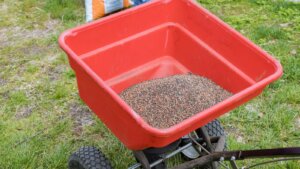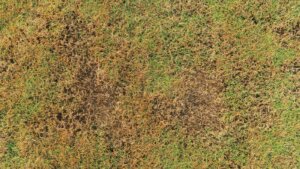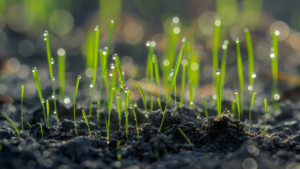Welcome to our comprehensive guide on lawn fertilization! Whether you’re a seasoned gardener or a homeowner looking to improve your green space, understanding the ins and outs of lawn fertilization is crucial. In this FAQ, we’ll cover everything from the importance of fertilization to choosing the right type of fertilizer for your lawn. Let’s dive in and unlock the secrets to a lush, vibrant lawn!
Why is Lawn Fertilization Essential for a Thriving Lawn?
- Nourishment: Fertilization is like a multivitamin for your lawn. It provides essential nutrients, including nitrogen, potassium, and phosphorus, the building blocks for a healthy lawn.
- Strength and Beauty: A well-fed lawn is not just about aesthetics. Yes, it’s greener, but it’s also more robust. Think of it as the difference between a well-nourished athlete and someone malnourished.
- Defense Mechanism: A robust lawn is like a fortress. It’s better equipped to fend off invaders like pests, withstand diseases, and endure environmental stresses like drought or excessive rainfall.
Think of fertilization as a spa treatment for your lawn. Just as we need regular care and nourishment, so does our lawn. Want to dive deeper? Discover the science behind lawn fertilization.
How Often is Fertilization Needed for My Lawn?
- General Rule: Most lawns are like us when we’re hungry – they need feeding three to four times a year. But remember, just like overeating isn’t good for us, over-fertilizing isn’t good for the lawn.
- Factors to Consider:
- Grass Type: Different grass species have different appetites. For instance, Bermuda might have different feeding times compared to Fescue.
- Soil Health: Think of this as the lawn’s digestive system. A healthy soil will absorb and utilize nutrients better.
- Climate: Just as we eat differently in summer and winter, lawns, too, have seasonal needs based on the local climate.
Need more details? Check out our comprehensive guide on How Often to Fertilize Your Lawn.
Which Fertilizer is the Best Fit for My Lawn?
- Know Your Grass: Every grass type has its own unique nutrient needs. It’s like humans needing different diets based on our activity levels and health needs.
- Cool-Season Grasses: Think of these as the folks who love autumn and spring. Varieties like Fescue or Ryegrass have specific nutrient requirements.
- Warm-Season Grasses: These are for summer lovers. Grasses like Bermuda or Zoysia have their own dietary preferences.
- Key Ingredients:
- Nitrogen: Promotes strong growth and vibrant color.
- Phosphorus: Supports strong root development.
- Potassium: Enhances disease resistance and drought tolerance.
Unsure about your choice? Learn more about Choosing the Right Fertilizer for Your Lawn.
When’s the Best Time to Fertilize My Lawn?
- Understanding Grass Seasons:
- Cool-Season Grasses: These are the types that thrive in cooler temperatures. Examples include Kentucky Bluegrass and Fescue.
- Optimal Fertilization Time:
- Early Spring: As the lawn “wakes up” from winter, it’s hungry for nutrients.
- Late Fall: This helps prepare the grass for the winter ahead, ensuring it remains robust.
- Optimal Fertilization Time:
- Warm-Season Grasses: These grasses love the heat! Think Bermuda or Zoysia.
- Optimal Fertilization Time:
- Late Spring: Right when these grasses start their rapid growth phase.
- Early Summer: To sustain the growth and keep that lush green appearance.
- Optimal Fertilization Time:
- Cool-Season Grasses: These are the types that thrive in cooler temperatures. Examples include Kentucky Bluegrass and Fescue.
Timing is everything, especially when it comes to lawn care. Feed your lawn at the right time, and it’ll reward you with a vibrant green carpet! Learn more about the Best Time to Fertilize Your Lawn.
Can Over-Fertilizing Harm My Lawn?
- The Grass Burn Phenomenon:
- Think of over-fertilizing as overfeeding. Just as too much food can harm us, excessive nutrients can “burn” the grass.
- Symptoms:
- Discoloration: Instead of a lush green, you might see a yellow or even brown hue.
- Patchiness: Random patches of distressed grass can appear.
- Prevention:
- Follow Instructions: Always adhere to the recommended dosage on the fertilizer package.
- Use a Spreader: This ensures even distribution, reducing the risk of dumping too much fertilizer in one spot.
To avoid the pitfalls of over-fertilization, read our guide on How to Avoid Over-Fertilizing Your Lawn.
How Long Should I Wait to Mow After Fertilizing?
- The Waiting Game:
- Why Wait?: Fertilizers need time to be absorbed. Mowing too soon can disturb this process.
- Optimal Waiting Period:
- Minimum: 24 hours.
- Ideal: 48 hours. This ensures the grass has absorbed the maximum nutrients.
- Additional Tips:
- Watering: Watering the lawn after fertilizing and before mowing is a good practice. This helps the grass absorb the nutrients and prepares it for mowing.
- Mower Blades: Ensure they’re sharp. Dull blades can cause unnecessary stress to freshly fertilized grass.
- Hook: Patience is a virtue, especially in lawn care. Give your lawn a little “me time” after its meal, and it’ll be ready for its trim in no time!
Thinking about professional mowing? Explore the offerings of Terra Lawn Care!
Is It Safe for Pets to Play on a Recently Fertilized Lawn?
- Safety First:
- Post-Fertilization: After treating your lawn, it’s essential to ensure the safety of your furry friends.
- Recommended Duration:
- Minimum: 24 hours. This allows the fertilizer to be absorbed and dry properly.
- Tips for Pet Owners:
- Create a Diversion: Engage your pets in indoor activities or play in a different area.
- Watering: Watering the lawn can help speed up the absorption process.
- Hook: We all love seeing our pets frolic on a lush lawn. A little patience ensures they do so safely!
For more tips on pet safety and lawn care, check out our guide: Is Lawn Fertilizer Safe for Dogs?.
Granular vs. Liquid Fertilizers: What’s the Difference?
- Understanding the Basics:
- Granular Fertilizers:
- Solid particles that are spread across the lawn.
- Advantages:
- Slow-release, providing nutrients over an extended period.
- Typically, less frequent applications.
- Liquid Fertilizers:
- Water-soluble solutions are sprayed onto the grass.
- Advantages:
- Immediate nutrient absorption.
- It can be combined with other lawn treatments.
- Granular Fertilizers:
Think of it as choosing between a hearty meal and a quick snack. Both have their place in lawn care, and Terra Lawn Care can guide you to the best choice!
Discover advanced fertilization techniques tailored for your lawn with Terra Lawn Care’s Guide on Granular Fertilizers and How to Use Liquid Fertilizers.
How to Spot an Under-Fertilized Lawn?
- Signs to Look Out For:
- Sluggish Growth: Your lawn doesn’t seem to be growing as robustly as before.
- Sparse Patches: Areas where the grass is thinning or not growing.
- Lackluster Hue: Instead of a vibrant green, the lawn appears pale or yellowish.
- Proactive Measures:
- Regular Checkups: Periodically inspect your lawn for any of the above signs.
- Soil Tests: These can reveal nutrient deficiencies and guide your fertilization strategy.
A lawn is like a living canvas, and its vibrancy tells a story. Ensure yours narrates a tale of health and vitality!
Why Choose Terra Lawn Care for Your Fertilization Needs?
- Experience and Expertise:
- Two Decades in the Field: We’ve seen it all and have honed our skills over the years.
- Organic Commitment: We believe in green in every sense, emphasizing organic lawn care.
- Local Know-How:
- Pennsylvania’s Pride: Our deep-rooted local knowledge ensures your lawn gets the best, tailored care.
- Personal Touch: We treat every lawn as if it were our own, ensuring attention to detail and utmost care.
In the world of lawn care, experience speaks volumes. With Terra Lawn Care, you’re not just getting a service; you’re investing in a legacy of excellence!
Ready to transform your lawn? Reach out to Terra Lawn Care today!
Final Thoughts: Cultivating a Lawn You’ll Love
In summary, lawn fertilization is not just a one-time task but an ongoing commitment to ensure the health and beauty of your lawn. From understanding the essential nutrients to knowing the right time for application, each aspect plays a significant role in your lawn’s well-being. We hope this FAQ has answered your questions and equipped you with the knowledge you need to make informed decisions. If you’re still unsure or need professional guidance, Terra Lawn Care is always here to help. Let’s make your lawn the envy of the neighborhood!



